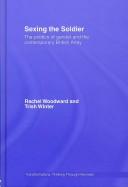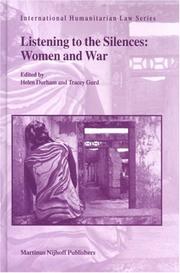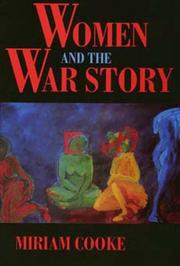| Listing 1 - 10 of 57 | << page >> |
Sort by
|
Book
ISBN: 9798216036890 9798216166405 1440857660 9781440857669 9781440857652 Year: 2018 Publisher: Santa Barbara : New York : ABC-CLIO, Bloomsbury Publishing (US),
Abstract | Keywords | Export | Availability | Bookmark
 Loading...
Loading...Choose an application
- Reference Manager
- EndNote
- RefWorks (Direct export to RefWorks)
Twenty-three countries currently allow women to serve in front-line combat positions and others with a high likelihood of direct enemy contact. This book examines how these decisions did or did not evolve in 47 countries. This timely and fascinating book explores how different countries have determined to allow women in the military to take on combat roles-whether out of a need for personnel, a desire for the military to reflect the values of the society, or the opinion that women improve military effectiveness-or, in contrast, have disallowed such a move on behalf of the state. In addition, many countries have insurgent or dissident factions, in that have led armed resistance to state authority in which women have been present, requiring national militaries and peacekeepers to engage them, incorporate them, or disarm and deradicalize them. This country-by country analysis of the role of women in conflicts includes insightful essays on such countries as Afghanistan, China, Germany, Iraq, Israel, Russia, and the United States. Each essay provides important background information to help readers to understand the cultural and political contexts in which women have been integrated into their countries' militaries, have engaged in combat during the course of conflict, and have come to positions of political power that affect military decisions.
Multi
ISBN: 9781009070089 9781009069045 Year: 2023 Publisher: Cambridge Cambridge University Press
Abstract | Keywords | Export | Availability | Bookmark
 Loading...
Loading...Choose an application
- Reference Manager
- EndNote
- RefWorks (Direct export to RefWorks)
This Element examines women warriors as vehicles of mobilisation. It argues that women warrior figures from the mid-nineteenth century until the end of the Second World War are best understood as examples of 'palimpsestic memory', as the way they were represented reflected new contexts while retaining traces of legendary models such as Joan of Arc, and of 'travelling memory', as their stories crossed geographical borders and were re-told and re-imagined. It considers both the instrumentalisation of women warriors by state actors to mobilise populations in the world wars, and by non-state actors in resistance, anti-colonial and feminist movements. Fell's analysis of a broad range of global conflicts helps us to understand who these actors were, what motivated them, and what meanings armed women embodied for them, enabling a fresh understanding of the woman warrior as an archetype in modern warfare.
Women soldiers. --- Women and the military. --- Women and war.

ISBN: 1134163622 1134163630 1280932163 9786610932160 0203946251 9780203946251 9781134163632 9781280932168 6610932166 9780415392563 041539256X 9780415392556 0415392551 Year: 2007 Publisher: London New York Routledge
Abstract | Keywords | Export | Availability | Bookmark
 Loading...
Loading...Choose an application
- Reference Manager
- EndNote
- RefWorks (Direct export to RefWorks)
Sexing the Soldier takes a critical look at how gender - what it means to be a man or a woman - is understood within the contemporary British Army, and the political and practical consequences of this. Drawing on original research, this informaive volume looks at:the history and structure of the British Army as a masculine institutionpersonnel policies which deal with gender issuesthe construction of ideas about military masculinities and femininities within the Armymedia representations of the figure of the soldier. Using case st
Women and the military --- Great Britain. --- Women. --- Femmes et forces armées --- Femmes et forces armées
Book
ISBN: 1565494059 9781565494053 9781565493100 1565493109 9781565493094 1565493095 Year: 2010 Publisher: Boulder
Abstract | Keywords | Export | Availability | Bookmark
 Loading...
Loading...Choose an application
- Reference Manager
- EndNote
- RefWorks (Direct export to RefWorks)
Women everywhere have long struggled for recognition as equal, productive members of society, worthy of taking part in the political process. These struggles become even more pronounced in times of conflict and war, when the symbolism and myths of womanhood are used to stoke nationalistic ideas about the survival of the state. Yet for all the rhetoric that takes place in their name, it's men who generally make decisions regarding war. Women and War examines how women respond to situations of conflict. Drawing on both traditional and feminist international relations theory, it explores the roles that women play before, during and after a conflict, how they spur and respond to nationalist and social movements, and how conceptions of gender are deeply intertwined with ideas about citizenship and the state. As Kaufman and Williams show, women do more than respond to conflict situations; they are active agents in their own right shaping political and historical processes. Their conclusions encourage us to rethink the prevalent assumptions of international relations, history and feminist scholarship and theory.
Women and war. --- Women and peace. --- Peace and women --- Peace --- Women pacifists --- War and women --- War --- Women and the military
Book
ISBN: 8490317038 9788490317037 9788490314739 849031473X Year: 2013 Publisher: Madrid : Dykinson,
Abstract | Keywords | Export | Availability | Bookmark
 Loading...
Loading...Choose an application
- Reference Manager
- EndNote
- RefWorks (Direct export to RefWorks)
Women and war. --- Kosovo War, 1998-1999. --- Mujer. --- Guerra. --- Kosovo Conflict, 1998-1999 --- Kosovo Crisis, 1998-1999 --- War and women --- War --- Women and the military
Book
ISBN: 1469653656 9781469653655 9781469653648 1469653648 9781469653631 146965363X 9798890870322 1469672502 Year: 2020 Publisher: Chapel Hill
Abstract | Keywords | Export | Availability | Bookmark
 Loading...
Loading...Choose an application
- Reference Manager
- EndNote
- RefWorks (Direct export to RefWorks)
"Historians of the Civil War often speak of "wars within a war"—the military fight, wartime struggles on the home front, and the political and moral battle to preserve the Union and end slavery. In this broadly conceived book, Thavolia Glymph provides a comprehensive new history of women's roles and lives in the Civil War—North and South, white and black, slave and free—showing how women were essentially and fully engaged in all three arenas. Glymph focuses on the ideas and ideologies that drove women's actions, allegiances, and politics. We encounter women as they stood their ground, moved into each other's territory, sought and found common ground, and fought for vastly different principles. Some women used all the tools and powers they could muster to prevent the radical transformations the war increasingly imposed, some fought with equal might for the same transformations, and other women fought simply to keep the war at bay as they waited for their husbands and sons to return home.Glymph shows how the Civil War exposed as never before the nation's fault lines, not just along race and class lines but also along the ragged boundaries of gender. However, Glymph makes clear that women's experiences were not new to the mid-nineteenth century; rather, many of them drew on memories of previous conflicts, like the American Revolution and the War of 1812, to make sense of the Civil War's disorder and death."--
HISTORY / Women --- Women and war --- War and women --- War --- Women and the military --- History --- United States --- Participation, Female --- Social aspects. --- Women. --- Women --- Participation, Female. --- Women and war.

ISBN: 9789004143654 9789047407430 Year: 2005 Publisher: Leiden; Boston : Brill | Nijhoff
Abstract | Keywords | Export | Availability | Bookmark
 Loading...
Loading...Choose an application
- Reference Manager
- EndNote
- RefWorks (Direct export to RefWorks)
Challenging the perception that women are exclusively the victims, the caregivers or the passive supporters of men in times of armed conflict, Listening to the Silences: Women and War exposes the reader to a diversity of women's voices. These voices, both personal and academic, demonstrate that women are increasingly taking on less 'traditional' roles during war, and that these roles are multifaceted, complicated and sometimes contradictory. The experiences of a judge, forensic anthropologist, survivor of sexual slavery, soldier, activist, journalist, humanitarian worker and others provide the reader with the opportunity to consider the depth of women's involvement in armed conflict. Their voices highlight the fact that the international community at large has historically failed to listen to women, even as they have tried to tell their own individual tales of horror, heroism, courage, devastation, betrayal, violence and integrity during armed conflict. Concurrently the book examines in detail the legal infrastructure in this area, including debates on the adequacy of international law; developments in jurisprudence and the implementation of international resolutions. This book reveals that responses to women's requirements during times of war will continue to be inadequate so long as we persist in silencing these differing perspectives and fail to take account of women's dynamic and changing needs during war. Listening to the Silences: Women and War is a collection of women's voices, each of which makes a unique contribution to a topic that is gathering international momentum and interest. The perspectives of these women greatly enhance our understanding of the gendered dimensions of armed conflict - they help to move the discourse beyond silence and towards inclusion, greater understanding and peace.
Humanitarian law --- War (International law) --- Women and war --- Humanitarian conventions --- International humanitarian law --- War and women --- War --- Women and the military --- Hostilities --- International law --- Neutrality
Book
ISBN: 9781009070089 9781009069045 Year: 2023 Publisher: Cambridge ; New York, NY : Cambridge University Press,
Abstract | Keywords | Export | Availability | Bookmark
 Loading...
Loading...Choose an application
- Reference Manager
- EndNote
- RefWorks (Direct export to RefWorks)
This Element examines women warriors as vehicles of mobilisation. It argues that women warrior figures from the mid-nineteenth century until the end of the Second World War are best understood as examples of 'palimpsestic memory', as the way they were represented reflected new contexts while retaining traces of legendary models such as Joan of Arc, and of 'travelling memory', as their stories crossed geographical borders and were re-told and re-imagined. It considers both the instrumentalisation of women warriors by state actors to mobilise populations in the world wars, and by non-state actors in resistance, anti-colonial and feminist movements. Fell's analysis of a broad range of global conflicts helps us to understand who these actors were, what motivated them, and what meanings armed women embodied for them, enabling a fresh understanding of the woman warrior as an archetype in modern warfare.
Women soldiers. --- Women and the military. --- Women and war. --- War and women --- War --- Women and the military --- Armed Forces and women --- Military, The, and women --- Women and the Armed Forces --- Armed Forces --- Women and war --- Women as soldiers --- Women in the military --- Soldiers

ISBN: 0520206126 0520206134 0585081387 0520918096 9780520918092 9780585081380 9780520206120 9780520206137 Year: 1996 Publisher: Berkeley University of California Press
Abstract | Keywords | Export | Availability | Bookmark
 Loading...
Loading...Choose an application
- Reference Manager
- EndNote
- RefWorks (Direct export to RefWorks)
In a book that radically and fundamentally revises the way we think about war, Miriam Cooke charts the emerging tradition of women's contributions to what she calls the "War Story," a genre formerly reserved for men. Concentrating on the contemporary literature of the Arab world, Cooke looks at how alternatives to the master narrative challenge the authority of experience and the permission to write. She shows how women who write themselves and their experiences into the War Story undo the masculine contract with violence, sexuality, and glory. There is no single War Story, Cooke concludes; the standard narrative--and with it the way we think about and conduct war--can be changed. As the traditional time, space, organization, and representation of war have shifted, so have ways of describing it. As drug wars, civil wars, gang wars, and ideological wars have moved into neighborhoods and homes, the line between combat zones and safe zones has blurred. Cooke shows how women's stories contest the acceptance of a dyadically structured world and break down the easy oppositions--home vs. front, civilian vs. combatant, war vs. peace, victory vs. defeat--that have framed, and ultimately promoted, war.
War stories --- War in literature --- Women and war --- Arabic fiction --- Women and literature --- Literature - General --- Languages & Literatures --- History and criticism --- Women authors --- Arabic literature --- War and women --- War --- Women and the military --- Literature --- Fiction
Book
ISBN: 9780521708791 9780511626852 9780521882224 Year: 2009 Publisher: Cambridge Cambridge University
Abstract | Keywords | Export | Availability | Bookmark
 Loading...
Loading...Choose an application
- Reference Manager
- EndNote
- RefWorks (Direct export to RefWorks)
Women and war --- Women, Palestinian Arab --- Women --- Human females --- Wimmin --- Woman --- Womon --- Womyn --- Females --- Human beings --- Femininity --- Palestinian Arab women --- War and women --- War --- Women and the military --- Social conditions --- Violence against
| Listing 1 - 10 of 57 | << page >> |
Sort by
|

 Search
Search Feedback
Feedback About UniCat
About UniCat  Help
Help News
News